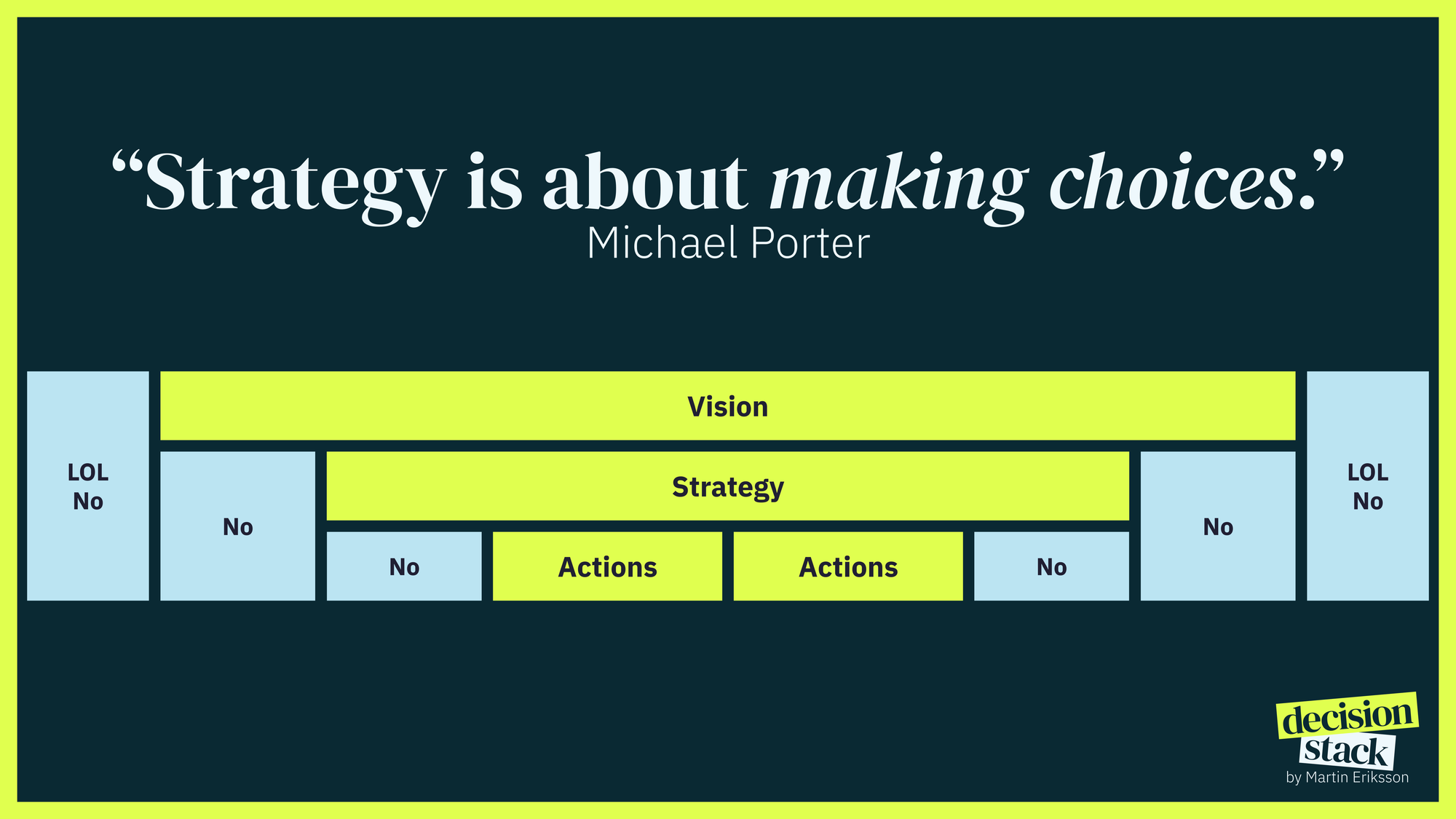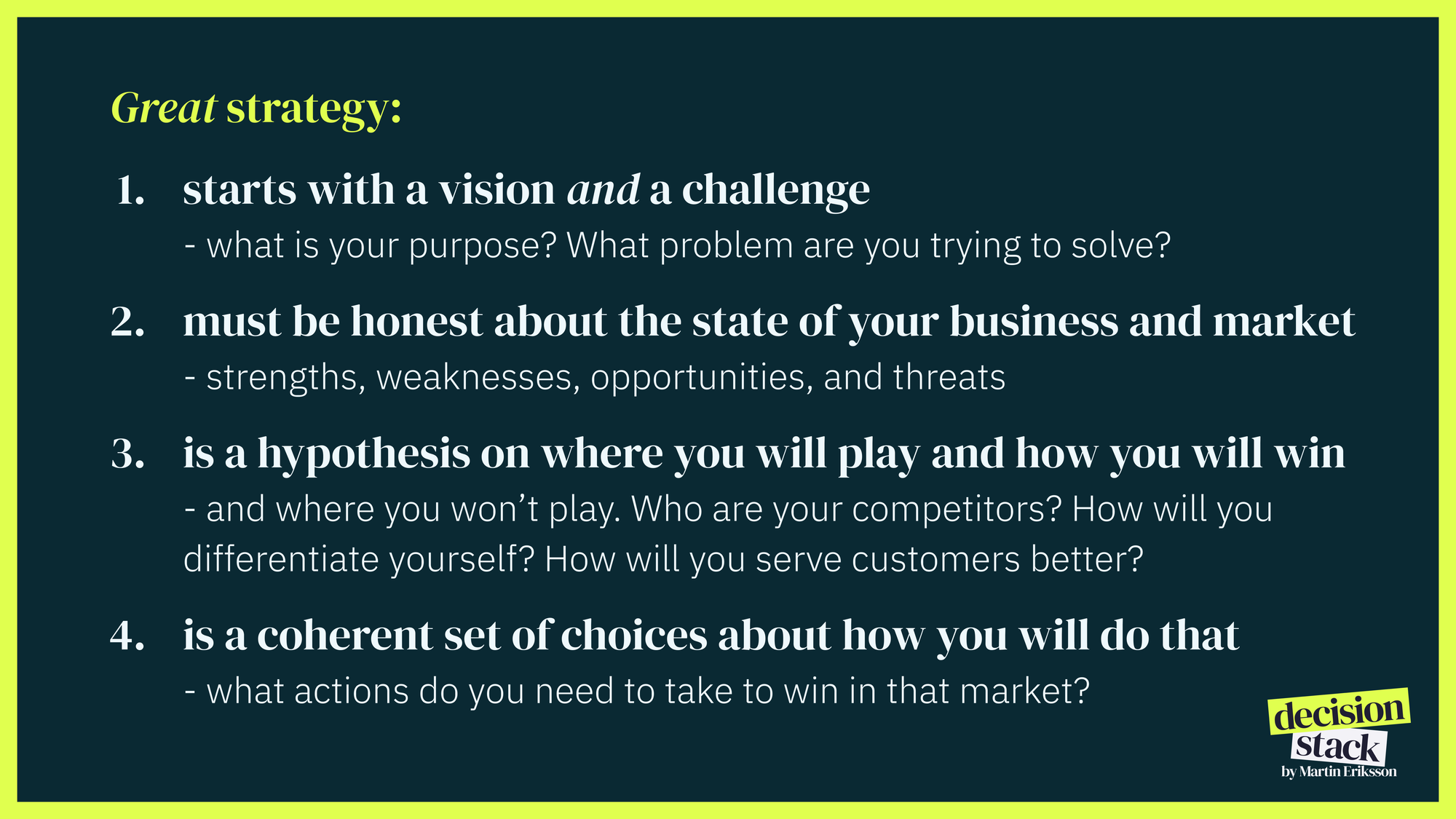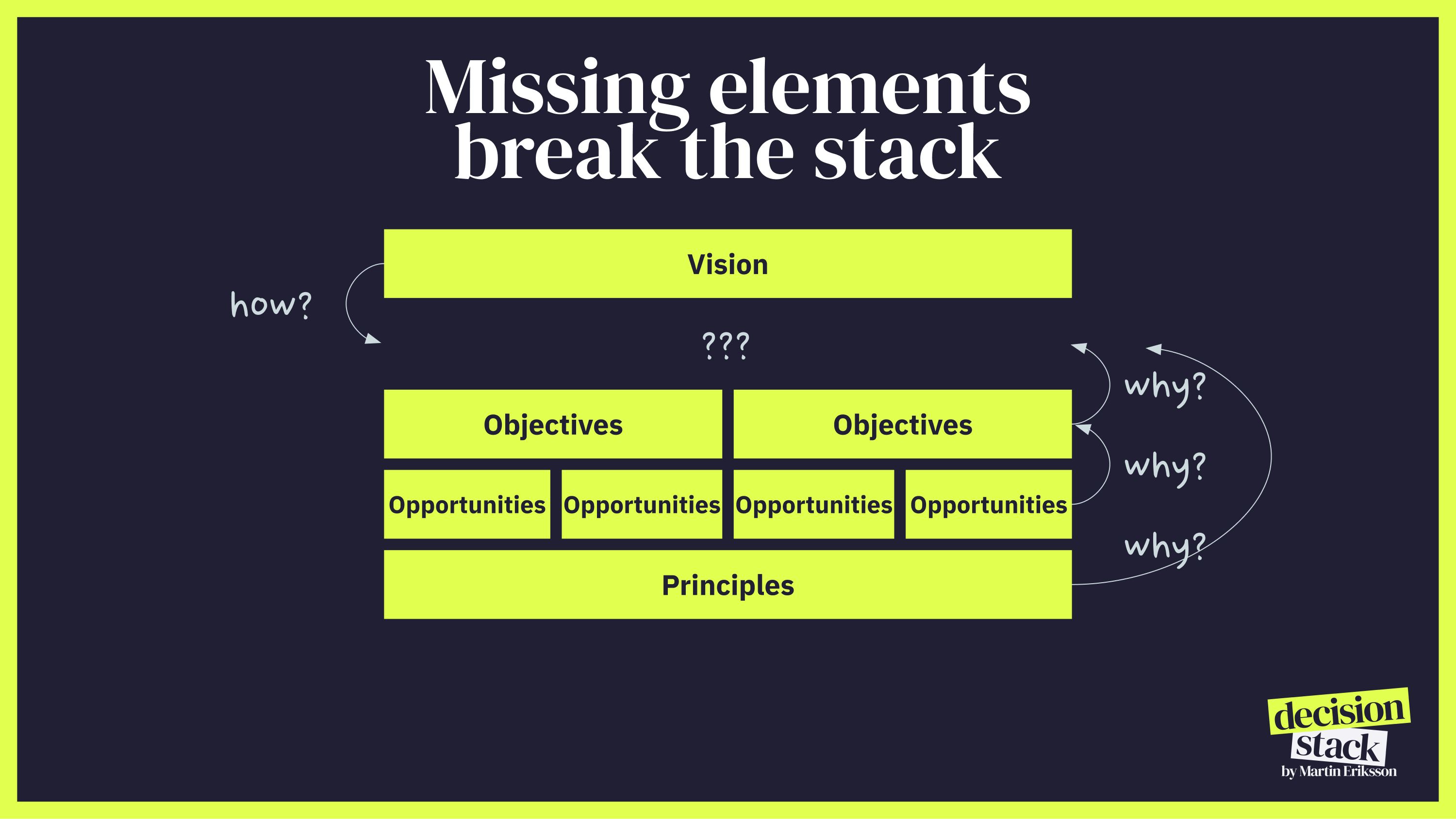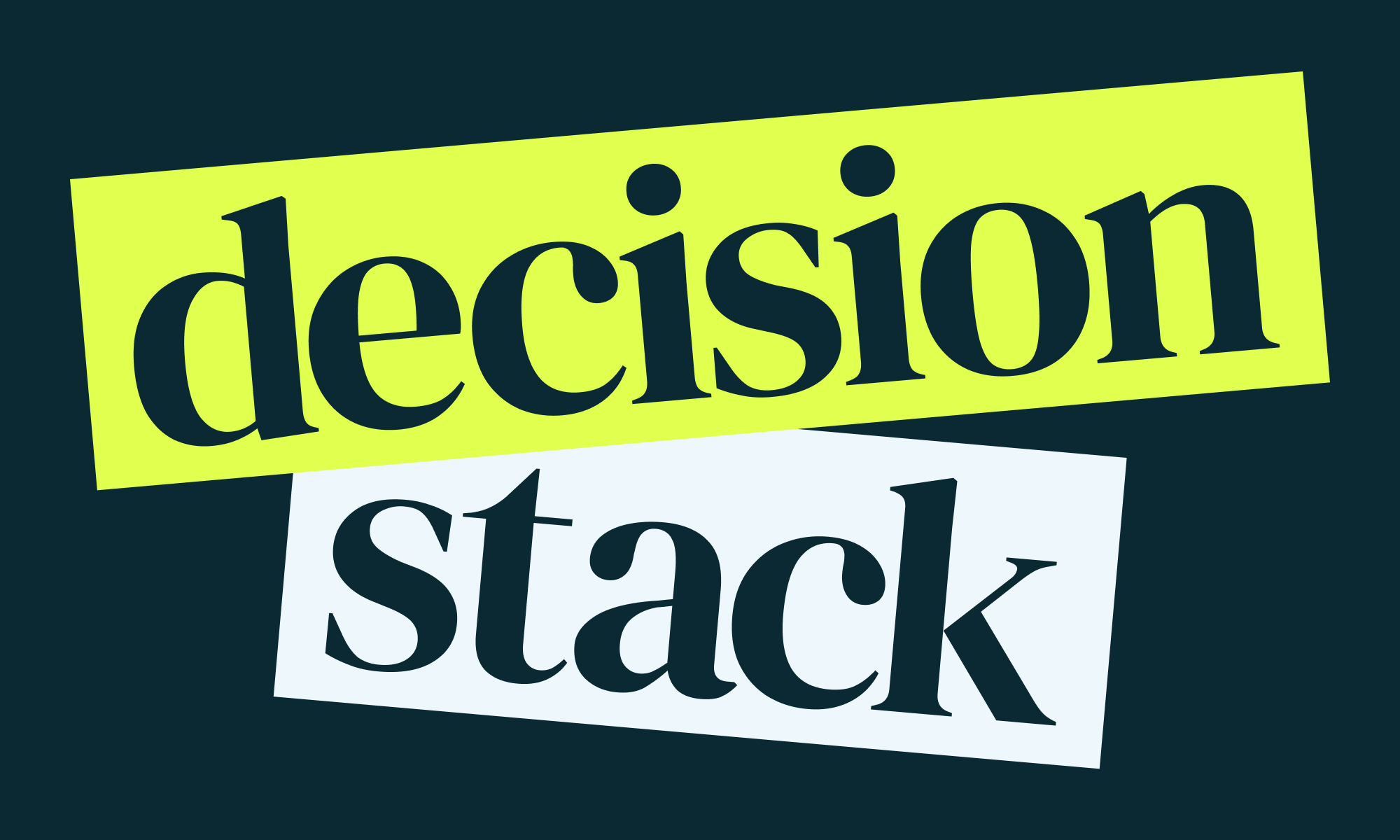Your strategy (probably) sucks
Discussing strategy quickly descends into a “right” way and a “wrong” way to do it but like most things in business and product the reality is more nuanced.

Sweeping generalizations. Semantic arguments. Discussing strategy quickly descends into a “right” way and a “wrong” way to do it but like most things in business and product the reality is more nuanced. But whatever your definition of strategy is, based on my experience advising hundreds of businesses, I’m fairly confident that your strategy isn’t as good as it could be.
The problem with (most) strategy
Too many companies out there simply don’t have a true strategy. A roadmap is not a strategy. OKRs are not a strategy. KPIs are not a strategy. A business plan is not a strategy. A vision, as important as it is, is not a strategy.
Even when companies have a strategy they often lack focus. If your strategy isn’t making tough choices about what you’re actually going to do as a business, you’re not providing the direction your team(s) needs. If you’re saying yes to more things than you’re saying no to, it’s going to lead to mediocrity, not success.
And even if they have an amazing strategy, too many companies lack clarity because they are terrible at communicating and disseminating that strategy to their teams. Don’t believe me? Ask a handful of your employees to articulate your strategy - in most companies you’ll get a different answer from every single person, if you get one at all.
What is strategy?
“Strategy is about making choices, trade offs; it’s about deliberately choosing to be different” - Michael Porter
There are as many different takes on strategy as there are economists and CEOs. And that’s ok. I like to lean on a few giants of strategy (because why try to reinvent the wheel?):
In 1979, as a relatively fresh associate professor, Michael Porter published his first article in HBR How competitive forces shape strategy where he says “the essence of strategy formulation is coping with competition”. This article and his subsequent best-selling 1980 book Competitive Strategy laid out the seminal Five Forces framework that define the external forces that impact a business: the threat of new entrants, the bargaining power of customers and of suppliers, the intense rivalry of competitors, and the threat of substitute services or products. In 1985 he followed this up with another best-selling book, Competitive Advantage, which looks inward and defines the value chain of a business - each of the elemental building blocks that drive performance. Taken together, Porter defines strategy as the specific way a company uses its advantages to create superior value for its customers and thus superior returns for the company.
In 2011 Richard Rumelt finally (he has been challenging strategic thinking since he first proved the statistical link between strategy and profitability in 1972) published his own book on strategy: Good Strategy / Bad Strategy. In this must read best-seller he dispels a lot of misconceptions about strategy - how we often confuse strategy with ambition, vision, or financial goals - and shows that a good strategy must focus on the challenge a business faces: “the core of strategy work is always the same: discovering the critical factors in a situation and designing a way of coordinating and focusing actions to deal with those factors”.
Later books that build on these ideas (among many others) include 2004’s Blue Ocean Strategy by Chan Kim & Renée Mauborgne that set out the importance of a simultaneous pursuit of differentiation to open up a new market space and create new demand. In 2014 A.G. Lafley (then CEO of Procter and Gamble) and Roger Martin outlined the strategic approach they took to double P&G’s sales, quadruple its profits, and increase its market value by more than $100 billion. Playing to Win defines successful strategy as two simple decisions: where to play and how to win. And in 2017, Hamilton Helmer published 7 Powers, which focused strategy on power - a set of conditions that create the potential for persistent differential returns.
I like to build on all of these seminal definitions, and define strategy simply as: Strategy is a coherent set of choices about what we are going to do in order to achieve our vision.
Crafting Strategy
With that in mind, great strategy:
- starts with a vision and a challenge. What is your purpose? What problem are you trying to solve?
- is honest about the current state of your business and market - strengths, weaknesses, opportunities, and threats.
- is a hypothesis on where you will play and how you will win. Your business and product don’t exist in a vacuum - your strategy has to consider your competition* and how to differentiate yourself.
- is a coherent set of choices and actions based on those insights.
* if you're an internal product, government department, or NGO think about context instead of competition - where do you fit in? who are your stakeholders? who else solves this problem? how can you stand out?
Does your business have clear answers to those points? I’m betting you don’t.

Strategy is a mindset, not an artefact
Before we dive in to how to get started on an effective strategy, it’s important to note that good strategy is first and foremost a mindset. There is no simple framework or canvas you can fill in and expect a strategy out the other end. The point of doing strategic work is not the slide deck at the end of it - it’s the hard work of looking at your data, research, discovery, and more to derive insight and understand what you think is your unique bet on the future. As the TV trope and meme says “the real treasure is the friends we made along the way”.
This also reinforces that strategy is not a one-and-done process. In a constantly evolving world your strategy has to be a constantly evolving playbook. Good strategy work and clarity go hand in hand here - the absolute best way to ensure that there is complete clarity on what your strategy is is to bring the whole company along on the journey to develop that strategy in the first place.
Build your strategy
Strategy is about making choices - but to make the right choices, you have to start with some hard-earned insights:
1. Start with the customer
Strategy always starts with an understanding of your customer and market. So get out of the building and talk to people. If you’re not sure where to begin, start with Steve Blank’s The Four Steps to the Epiphany. His customer development process lays out how to turn your vision into hypotheses, and how to take those hypotheses out into the world and validate them. If you’re already on the way, simply gather all the research, data, and insights you have about your customers and spend time synthesising and sifting through them to immerse yourself (and your team) in them.
2. Know where you’re going
Where are you trying to go? What does your customer’s life look like when you’ve solved this problem? Where do you want your strategy to take the company? Hopefully you already have a strong, customer-focused vision that describes this (but if not, that is a blog post for another time). Your vision should be an aspirational statement about the world you want to create; Your strategy will describe the actions you’ll take to make that vision a reality.
3. Be honest
Any good strategy has at its core an honest assessment about where you are today. Use a framework—any framework—to observe your current position and determine how you can move forward. For example, running a SWOT analysis is a simple way to understand your customers, your competitive position, what’s working and what’s not, and begin some strategic planning. SWOT stands for strengths, weaknesses, opportunities, and threats. By brainstorming these four lists, you can get an instant insight into where you stand right now. SWOT has its faults, but it’s been around since 1965 and was in your Introduction to Business class for a reason - it really helps you be honest about your advantages over competitors, your weak spots, your market standing, and industry trends.
4. Make tough choices
As you start to codify your strategy, think about your strategy as a focused bet on the future. To do this:
- Be specific: A phrase like "grow revenue" is too vague. A good strategy talks about what you're going to do to increase revenue. Are you opening a new market? Targeting a new segment? Solving a new customer problem? Put that language in your strategy instead.
- Be coherent: Good strategy is logical and connected. Instead of listing a slew of generic KPIs, create a clear story that reinforces your vision and strategic actions that mutually support each other towards that vision.
- Be focused: Your strategy should force you to make tough choices. It should help you say “no” to lots of good ideas so you can focus on the best ones.
People think focus means saying yes to the thing you've got to focus on. But that's not what it means at all. It means saying no to the hundred other good ideas that there are. You have to pick carefully. - Steve Jobs
5. Prioritise and sequence
Think big, start small. Making tough choices doesn’t mean saying no forever - it means having a clear view of the sequence of actions you need to take towards your larger vision. If your goal is to create a full suite of products for your customer, don’t lose sight of that but focus on building the most important part of that suite first, and doing it really well before you move on to the next.
Think of this as a series of product/market fits. The most successful companies nail the right product in the right market before they expand either the product set or market target. If you try to do it all at once, you’ll never hit product/market fit in any of them.
“So often people are working hard at the wrong thing. Working on the right thing is more important than working hard.” – Caterina Fake
Product strategy vs business strategy
The strategy I’m urging you to create isn’t focused on product alone. It's impossible to set a product (or marketing, tech, sales, etc) strategy in a vacuum. As a [insert function here] leader it is your responsibility to work with the rest of your leadership team to ensure the business has a clear, overarching, mutually reinforcing strategy that gives direction to every part of the business on what they should be focusing on.
Once the business strategy is clear, creating a product (or marketing, tech, sales, etc) strategy becomes much much easier. What do you need to do to achieve the business strategy? If you've made the right tough choices at the business level this will be surprisingly easy to answer.
Business plan vs strategy
I see way too many businesses who's strategy boils down to "grow revenue" and inevitably you can trace this back to a business plan or model that lays out the P&L for the next 5 years. While a business plan is an important planning tool, it should always come after a strategy, not before it.
Now don't get me wrong, if you're a for-profit organisation, growing revenue and profitability is ultimately the reason you exist. But great strategy doesn't just extrapolate a revenue number, it outlines the actions you're going to take to achieve that growth.
But the flipside is that a great strategy isn't just aspirational, it's a realistic plan about how you're going to succeed - and good plans involve real numbers.
Strategy isn’t set in stone
If crafting a strategy seems restrictive, remember this: Whatever you decide now will morph later. Most strategy books talk about 3-5 year strategies, but one size does not fit all. In the early stages of a product or business, you might be iterating your strategy incredibly quickly as you take action, make bets, and observe the outcome of those bets. As your business or product becomes more established, your strategic arcs will get longer. So while an established business might be looking 3, 5, or even 10 years out - a new product within that business might be iterating on strategy every few months, and a startup strategy is probably only as long as it's runway.
Regardless of how far out your strategy looks, it is never a one and done deal. Even in an established business you have to check in regularly to make sure the strategy is working and you’re heading in the right direction. And you always have to be willing to incorporate new findings. If you’ve learned anything new that invalidates your strategy, that means you should rethink it. So if you're a startup and your strategy looks out 18 months, you should probably check in every month. If you're more established and your strategy is looking 3-5 years out check in every quarter to see if it still makes sense. If you’ve done the upfront work it probably won’t need changing that often, but every once in a while it might, and you’ll be glad you didn’t wait another few years before making sure.
Always have a few different scenarios in mind, too. What happens if interest rates change? What happens if you can’t raise more money? What happens if a major competitor pivots into your space? What happens if that web mobile AI “fad” becomes a real trend? Is your strategy flexible enough to adapt if the market shifts? Create a set of guidelines that will help you course-correct. You don’t want to get caught wrong-footed.
Strategy is everyone's responsibility
Your strategy is the lifeblood of your company. Everyone must understand it and feel invested in it. Which means you can’t create it in an ivory tower then hand it down to your team. You have to involve them in the process to increase ownership and clarity.
Because no matter how good your strategy is - if it’s not clear to your team, no one will be able to execute on it. John Maeda once said, "Clarity comes from transparency and understanding". I completely agree. If you’re communicating your strategy in ways that don’t connect for your team members, keep trying - but the best way is to bring them along on the journey.
And even if you feel like you're too junior to affect that strategy, get involved. No matter where you are in the organisation, you can always be more strategic. One of the best ways to do this and challenge leadership to be more strategic is to make sure that you challenge assumptions and ask why this work is important. The more you keep asking why - as the Decision Stack shows - the more you force those above you to also consider strategy and vision and to clarify them for you.

But sometimes you have to disagree and commit
At the end of the day though, you have to start acting on that strategy, so it is important to "disagree and commit" as Jeff Bezos says. Once everyone has had their say, asked the hard questions, and presented evidence/insight to back it up, leadership has to pick a direction and move to execute on it.
We live in an imperfect world, and will never have all the information needed to make a perfect strategic decision. So it is leadership's job to synthesise all their experience, insights, and input, follow their intuition and decide on a bet. The key is to communicate why you've made that decision, and to unpack the assumptions that go into it so you can test them quickly and course correct if needed.
Strategy is hard
Strategy is the connective tissue between vision and execution - which is really really hard. But that's no excuse to avoid it or assume someone else will do it for you. Whether you drive it from the top down, or the bottom up, a clear strategy is critical to providing the direction and context everyone in your organisation needs to make better decisions, faster.
The more you read, think, or listen to people discuss strategy, the more the words and frameworks can lose all meaning. When it comes down to it, go back to first principles - understand what you are trying to achieve and for whom and be intentional about what you need to do to get there (and what you won't do).
How do you think about strategy? Anything I've missed? Comment below!

